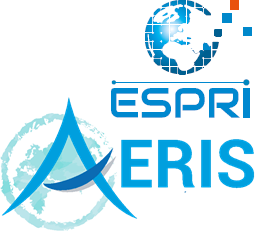
ESPRI Data Centre (former Ether)
ESPRI is a data centre of the French Atmosphere Infrastructure AERIS
ESPRI is a data centre of the French Atmosphere Infrastructure AERIS

.................................
ACOMIDA home page
......................................
ADOMOCA work group
......................................
ADOMOCA newsletter
......................................
ADOMOCA model
.................................
Overview of the ADOMOCA project
The aim of this project is to better organise the French atmospheric chemistry community for research into the assimilation of existing and future tropospheric and stratospheric chemistry data.
Due to the range of tools available (models, space measurements, assimilation methods), the PALM coupler, developed at CERFACS, was deemed most suitable for this project. Two models were selected: MOCAGE at CNRM and LMDz-INCA at the Institut Pierre-Simon Laplace (IPSL), taking the MSDOL tool as a starting point. Two contract engineers (at CERFACS and IPSL) were funded by CNES to adapt the models and the assimilation methods (3DFGAT, 4DVAR and linear interpolation) to the PALM coupler and to assist the scientific community to develop observation operators for the various space sensors.
During a CERFACS workshop in January 2005, community members involved in the ADOMOCA project (which currently comprises CERFACS, CNRM, the Service d'Aéronomie, the Laboratoire des Sciences du Climat et de l'Environnement, LISA, the Laboratoire d'Aérologie and more recently Noveltis) decided to focus on the following two scientific areas:
The observation operators for the GOMOS and MOPITT instruments will be developed by the Service d'Aéronomie and the Laboratoire d'Aérologie respectively. An optimal interpolation method will be 'PALMerised'' at CERFACS. The MSDOL and LMDz-INCA models will be 'PALMerised' at the IPSL by a newly-recruited engineer. It will then be possible to assimilate the measurement fields for GOME, Odin/SMR, ENVISAT/MIPAS, ENVISAT/GOMOS, TERRA/MOPITT in 3DFGAT, 4DVAR and optimal interpolation. A preliminary study by Noveltis (through a three-month contract with CNES in 2005) is underway to develop the observation operator for CO and 03 for the IASI satellite instrument, as well as the assimilation of future IASI measurements in the CHIMERE model. Other stratospheric and tropospheric studies will be undertaken by various laboratories using their own research tools, i.e.: without using the PALM coupler. In this case, we suggest that the chemical component fields assimilated in this way be used to estimate the quality of fields produced using the PALM coupler. Eventually, over the coming four years, within the ADOMOCA community, we hope to achieve the following:
NB: Since 2014, The Ether Atmospheric Chemistry Data Centre became CDS ESPRI/IPSL.
- Ozone budget (stratosphere)
- Pollutant transport (troposphere)
- UT/LS Tropics (coordinated by J.-P. Pommereau),
- UT/LS satellites (coordinated by A. Hauchecorne and M. Marchand),
- Large-scale transport (coordinated by Hassan Ben Chérif),
- ITOP campaign (coordinated by K. Law),
- Pollution in Asia (coordinated by J.-P. Cammas),
- Towards communal modelling of atmospheric chemistry, from a regional to a global scale (coordinated by D. Hauglustaine and V.-H. Peuch).
- ozone measurements from the SAGE III, POAM III, HALOE and ACE satellite instruments, from the MOZAIC aircraft network, the ER-2 research aircraft and the NDSC and Dobson ground-based networks of instruments,
- ozone fields assimilated using research tools developed by each project component: MSDOL, MIMOSA-CHIM, etc.
The observation operators for the GOMOS and MOPITT instruments will be developed by the Service d'Aéronomie and the Laboratoire d'Aérologie respectively. An optimal interpolation method will be 'PALMerised'' at CERFACS. The MSDOL and LMDz-INCA models will be 'PALMerised' at the IPSL by a newly-recruited engineer. It will then be possible to assimilate the measurement fields for GOME, Odin/SMR, ENVISAT/MIPAS, ENVISAT/GOMOS, TERRA/MOPITT in 3DFGAT, 4DVAR and optimal interpolation. A preliminary study by Noveltis (through a three-month contract with CNES in 2005) is underway to develop the observation operator for CO and 03 for the IASI satellite instrument, as well as the assimilation of future IASI measurements in the CHIMERE model. Other stratospheric and tropospheric studies will be undertaken by various laboratories using their own research tools, i.e.: without using the PALM coupler. In this case, we suggest that the chemical component fields assimilated in this way be used to estimate the quality of fields produced using the PALM coupler. Eventually, over the coming four years, within the ADOMOCA community, we hope to achieve the following:
- Assimilation of a given chemical species obtained from several different space sensors in the troposphere or the stratosphere (O3 and CO),
- Coupling of the stratospheric and tropospheric measurements for a given chemical species obtained from several different space sensors (O3, CO and HNO3),
- Assimilation of several chemical species from the same family obtained from several different space sensors (NOy, Cly),
- Assimilation of direct measurements (brightness temperature, radiance temperature),
- Provision of forecasting fields for chemical compounds (O3, CO),
- Study of the impact of chemical tracers (O3) on assimilation and meteorological forecasting (winds in the lower stratosphere, radiation).
- satellite measurement fields as input for our assimilation studies,
- supplementary measurement fields (satellite, aircraft and ground) during the validation phase for PALM-assimilated fields,
- the necessary tools (forcing files, sources, scripts) for implementing the 'PALMerised' MOCAGE system on a local platform.
NB: Since 2014, The Ether Atmospheric Chemistry Data Centre became CDS ESPRI/IPSL.


